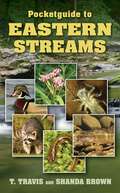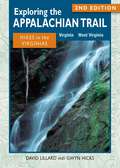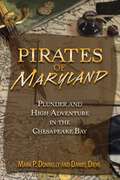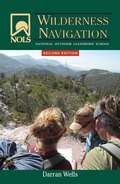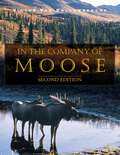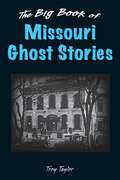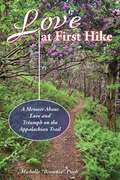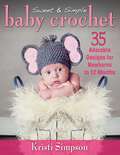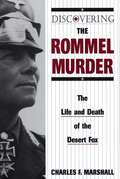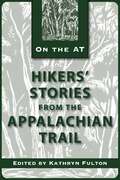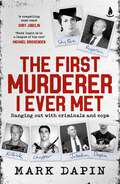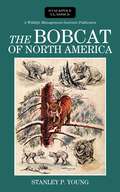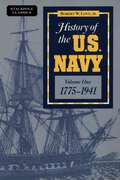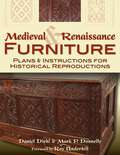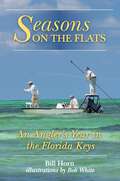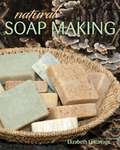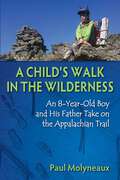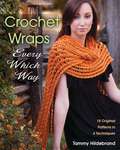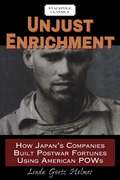- Table View
- List View
Pocketguide to Eastern Streams
by T. Travis Shanda BrownSpecies accounts and photos for 225 plants, trees, insects, mollusks, fish, amphibians, reptiles, mammals, and birds commonly found in and around streams.
Pop-Up Cards and Invitations
by Maurice MathonUnder $15, and includes 15 preprinted, ready-to-cut designs!Make your own colorful pop-up cards simply by cutting, scoring, folding, and gluing ordinary papers and cardstock Detailed instructions and full-size patterns for 20 cards for birthdays, holidays, special events, invitations, and greeting cards.
Exploring the Appalachian Trail: Hikes in the Virginias (Exploring the Appalachian Trail)
by David Lillard Gwyn HicksA guide to 46 day hikes and overnight trips in Virginia and West Virginia.
Pirates of Maryland
by Mark P. Donnelly Daniel DiehlHigh adventure, dastardly deeds, and newly uncovered lore.
NOLS Wilderness Navigation (NOLS Library)
by Jon Cox Darran WellsThe National Outdoor Leadership School's official guide to finding your way in the wilderness.
In the Company of Moose
by Victor VanBallenbergheWildlife biologist Victor Van Ballenberghe gives insights into the species, their habitat, and predators.
Haunted Minnesota (Haunted Series)
by Charles A. Stansfield Jr.Includes• Arrowhead's Devil Dogs• Spirits of the Vikings• Phantom racehorse Dan Patch• The legend of the fearsome Windego• The ghost ship Minnesota
Big Book of Missouri Ghost Stories (Big Book of Ghost Stories)
by Troy TaylorThe Show Me State's creepiest accounts of ghosts and hauntings.
Love at First Hike
by Michelle PughWhen recent graduate Michelle Pugh sets out to fulfill a childhood dream of hiking the A.T. from start to finish, she enjoys the bliss of being surrounded by nature, the peacefulness of small trail towns, and the companionship of fellow hikers.
Sweet & Simple Baby Crochet
by Kristi SimpsonDress Your Little One in Handmade Love!Choose from 35 delightful designs for boys and girls, with sizing from newborn to 12 months. There are adorable hats and headbands, blankets, diaper covers, tops, sweaters, and so much more. And if you've always wanted to learn to crochet, there are lots of cute designs perfect for beginners, plus a stitch guide with step-by-step photos that will teach you everything you need to know to crochet like a pro on your very first project.
Discovering the Rommel Murder (Stackpole Classics)
by Charles F. MarshallField Marshal Erwin Rommel's heroic opposition to Hitler in 1944 cost him his life. In this intriguing, well-paced tale of a journalistic coup, Marshall, the first to discover the real events behind Rommel's death, tells how he learned the facts from Rommel's widow and delves into the great general's background and death. He arrived at his conclusions based on his intimate knowledge of men on Rommel's staff and his access to Rommel's papers, including letters from the general to his wife. Here, for the first time in paperback, is the exciting story of how the world learned about the way the "Desert Fox" met his death.
Hikers' Stories from the Appalachian Trail
by Kathryn FultonCollection of highlights from twenty-one Appalachian Trail blogs.
The First Murderer I Ever Met: Hanging out with criminals and cops
by Mark DapinFor more than thirty years, Mark Dapin has been hanging out with crooks, and both types of cop. In this gripping, often funny and always surprising book, he sorts the tall stories from the truth about true crime, showing us what some of Australia&’s most famous felons are really like.Mark Dapin was still in school when he met his first murderer – a boy called Ian. In reporting the murder Ian eventually committed, newspapers used the cliché that it &‘shocked even those who knew him best&’. But it didn&’t shock Dapin, because he knew Ian in real life, not in clichés.Criminals are sensationalised in the press and mythologised in their own stories. In describing criminals, police and prison officers he&’s spent time with, Dapin searches for the real characters and events. How many of Chopper Read&’s stories were actually true? What's it like at home with former murder cop Gary Jubelin? Was the biggest art heist in Australian history carried out by one of Dapin&’s neighbours, the mysterious Sky Blue? And what happens when you go to visit a prison with celebrated escapee John Killick? These encounters are better than a ring-side seat to the underworld: Dapin gets in the ring.The First Murderer I Ever Met is the truest true crime – it&’s what actually happened.
Unerring Fire (Stackpole Classics)
by Richard FuchsWhat really happened at Fort Pillow on April 12, 1864?The Union called it a massacre.The Confederacy called it necessity.TheTennessee spring came early that year, &“awakening regional plants as warmer air and mois soil nurtured new life. Across the landscape could be seen the faint hint of green as sweet gum, hickory, oak cottonwood,…Sweet Williams, and wild dogwood added their hues.&” This serene backdrop in hardly the place where one would imagine such a one-sided military atrocity to take place.Although at first glance the numbers are hardly noteworthy, the casualty ratio speaks volumes on the event. Eyewitness accounts relate &“vivid recollection&” of the numerous and specific nature of the injuries suffered by the survivors.&”Controversy and scandal surround the Southern general Nathan Bedford Forrest. Why did it seem that he passively watched his men attack and mutilate more than one hundred apparently unarmed soldiers?Perhaps the biggest controversy involved racial prejudice. Was there a reason that Fort Pillow was singled out for Confederate vengeance, with the knowledge that the majority of the men were African-American? Of the dead, 66 percent were black.An Unerring Fire answers these questions and more in a critical examination of what remains one of the most controversial episodes of the Civil War.
Bobcat of North America (Wildlife Management Institute Classics)
by Stanley P. YoungIn this volume Stanley P. Young completes his series of monographs on the major predatory mammals of North America. As in his earlier works, The Wolves of North America; The Puma, Mysterious American Cat; and The Clever Coyote, Mr. Young writes with the authority of a field biologist who has studied his subjects for more than a quarter of a century in the intimacy of their own habitat, from coast to coast and from the northern limits of their range in Alaska and Canada to the deserts of Mexico.Mr. Young, now Director of Bird and Mammal Laboratories in the Branch of Wildlife Research of the U.S. Fish and Wildlife Service, began his career as a biologist in the old Bureau of Biological Survey When much of the Activity of that agency hinged around the control of predatory animals. In this and in later capacities he has probably handled, weighed, measured, and studied more specimens, alive and dead, of the bobcat in its many races than any other scientist. In addition to his own wide experiences he has drawn upon the wealth of records and field observations of farmers, stockmen, trappers, predator hunters, state and federal biologists, and wildlife technicians in the files of the U.S. Fish and Wildlife Service. The book is a complete scientific study of the subject from every angle, interestingly spiced with anecdotes from the author&’s own rich personal experience.How big is a &“big&” bobcat? How serious is bobcat predation on game animals? How can a small bobcat pull down and kill a deer five times its own weight? What are the habits and habitat of the bobcat? What are the ranges of its various scientifically recognized races? All of these questions and many more are answered in the pages of this generously illustrated book.
History of the U.S. Navy (Stackpole Classics)
by Robert W. LoveThis is the exciting story of the American Navy and its important role in our nation&’s history from the Revolutionary War to the dawn of the New World Order. Presented in two volumes, Robert Love shows how the interplay of international affairs, foreign policy, partisan politics, changing technology, and Navy views has shaped the American fleet and continues to define its missions and operations.
Salt Water's Greatest Gamefish
by Tom BoydA guide to essential tackle, techniques, and strategy for the world's top saltwater species, on both conventional tackle and fly. Includes information on how and where to catch all the fastest, toughest, and biggest saltwater gamefish, including striped bass, bonefish, tarpon, tuna, mako sharks, and more.
Performance Fly Casting
by Jon Cave99 detailed illustrations by Joe MahlerCommon casting mistakes and their solutionsPractical, comprehensive casting instruction for developing a smooth and relaxed delivery, throwing tighter loops, and achieving greater distance effortlesslyCasting under windy conditions, eliminating slack, increasing accuracy, making better presentations, and double-hauling efficiently
Medieval & Renaissance Furniture
by Mark P. Donnelly Daniel Diehl36 projects for historic benches, chairs, tables, cupboards, chests, shelves, beds, and doors, all done with simple woodworking tools.
Seasons on the Flats
by Bill HornMigrations of fish, rise and fall of tides, and weather changes through the year in the Keys.
Guide to Personal Financial Planning for the Armed Forces
by Colonel S. Gayton Major Scott HandlerComplete information and advice on personal finances and important decisions, tailored to members of the armed forces.
Natural Soap Making
by Elizabeth Letcavage Melissa HardenHow to make cold-process soap (soap from scratch) using only natural fragrances, colorants, and texture additives.
Child's Walk in the Wilderness: An 8-Year-Old Boy and His Father Take on the Appalachian Trail
by Paul Molyneaux Asher MolyneauxImagine a 7-year-old boy asking his father if they can hike the entire Appalachian Trail, and then imagine that the father says yes.
Crochet Wraps Every Which Way
by Tammy HildebrandPatterns for 18 wraps and shawls using 6 crochet techniques: traditional crochet, motif crochet, Tunisian crochet, broomstick lace, hairpin lace, and double-ended crochet.
Unjust Enrichment (Stackpole Classics)
by Linda Goetz HolmesThe use of American POW's as slave labor by Japanese companies is the great unresolved issue of the Second World War in the Pacific. Unjust Enrichment provides a forum for American servicemen to tell their own stories, while Linda Holmes gives the reader the historic context to recognize the seriousness of the crimes.Bio: Linda Goetz Holmes has been interviewing and writing about World War II prisoners in the Pacific for over 30 years. She is the first historian appointed to the U.S. Government Interagency Working Group, formed in 1999 under the aegis of the National Archives to locate and declassify material about World War II war crimes.
